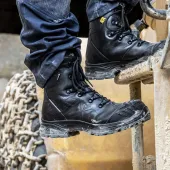New PPE guidance documents from BSIF
BSIF to publish guides on combined head/hearing protection, protective gloves and safety footwear
THE British Safety Industry Federation (BSIF) is planning three new guidance documents for 2016 to help users and specifiers select the most appropriate personal protective equipment (PPE) to meet their needs.
The guides will be on combined head and hearing protection, protective gloves, and safety footwear, all of which are areas where standards have recently changed or the information currently available has proved unclear or confusing.
When selecting safety helmets and earmuffs to use together, users will find that most helmets have an accessory slot at each side for earmuffs, and many manufacturers offer helmet-mounted earmuffs.
Often, the fitting points of the helmet and earmuff are of a ‘standard’ size and style, and it is here that a significant issue can arise, according to the BSIF. It says that if you select a helmet from one manufacturer and earmuffs from another, they may well fit together, but unless you can see that they have been performance tested together there is nothing to show that the earmuffs will provide the expected protection.
If products are selected from different sources, the user should make sure to check that the earmuffs have been tested on the specific make and model of helmet with which they are to be used. Just because it fits, does not mean it works, says the BSIF.
The main EN standard for protective gloves – EN 388 ‘Protective gloves against mechanical risks’ – has recently been the subject of a major review, resulting in substantial changes which every specifier and user needs to be aware of.
When the revised standard is published in the first half of 2016, it will introduce a new marking scheme to indicate levels of cut-resistance performance. The change from the old to the new marking scheme needs to be clearly explained and widely communicated to all who are at risk.
Recognizing this need, the BSIF will proactively develop a communication package designed to reach across the spectrum of stakeholders from manufacturers and distributors, through safety professionals to specifiers and end-users.
Meanwhile, safety footwear standards include a number of classes which shoes and boots can be certified to, depending on their performance. Markings such as SRA, SRB and SRC relate to slip resistance with two different surface/liquid challenges, or a combination of both.
According to the BSIF, the market has adopted the idea that selecting the combination marking provides the best of both worlds, but this is not necessarily true. It says those marked to a single challenge may deliver much better performance in their particular situation.
In addition, there are a number of common misconceptions about other areas of safety footwear, such as waterproofing and electrical resistance, and the new BSIF guidance will provide a definitive explanation to better inform users and specifiers when making their selection.









